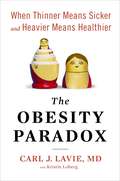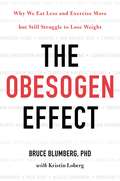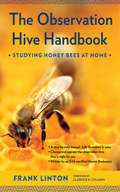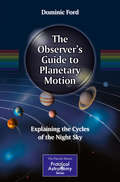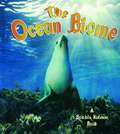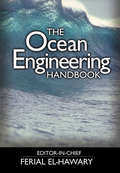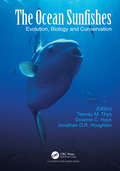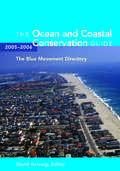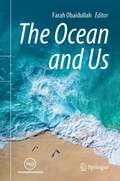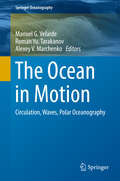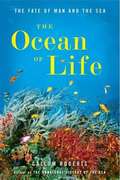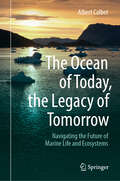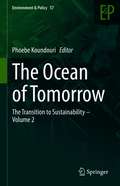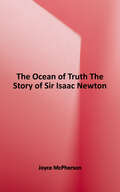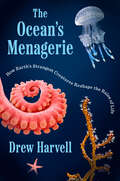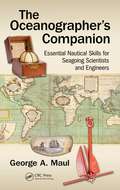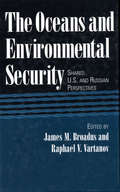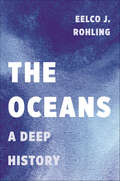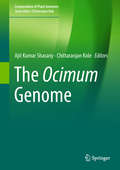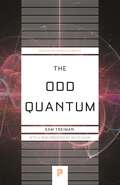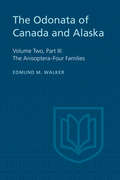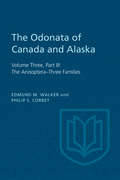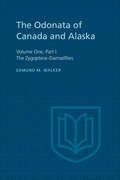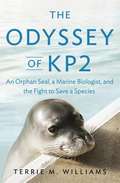- Table View
- List View
The Obesity Paradox
by Carl J. LavieMost of us think that longevity hinges on maintaining a normal Body Mass Index. But research conducted over the last decade hit the media in January with explosive news: Overweight and even moderately obese people with certain chronic diseases#151;from heart disease to cancer#151; often live longer and fare better than normalweight individuals with the same ailments. In this groundbreaking book, Carl Lavie, MD, reveals the science behind the obesity paradox and shows us how to achieve maximum health rather than minimum weight. Lavie not only explains how extra fat provides additional fuel to help fight illness, he also argues that we’ve gotten so used to framing health issues in terms of obesity that we overlook other potential causes of disease. Picking up where the bestseller Fat Chance left off, The Obesity Paradox will change the conversation about fat#151;and what it means to be healthy.
The Obesogen Effect: Why We Eat Less And Exercise More But Still Struggle To Lose Weight
by Kristin Loberg Bruce BlumbergAn eye-opening account of the landmark research into the hidden chemicals that are endangering our health and keeping us fatBeing overweight is not just the result of too many cheeseburgers or not enough exercise. According to leading-edge science, there are silent saboteurs in our daily lives that contribute greatly to our obesity epidemic: obesogens. These weight-inducing offenders, most of which are chemicals, disrupt our hormonal systems, alter how we create and store fat, and change how we respond to dietary choices. Because they are largely unregulated, obesogens lurk all around us-in food, furniture, plastic products such as water bottles and food storage containers, and other surprising exposure points. Even worse: research has shown that the effects of some obesogens can be passed on to future generations by irreversibly interfering with the expression of our genes. The good news is we can protect ourselves by becoming more informed consumers. In THE OBESOGEN EFFECT, Dr. Bruce Blumberg describes how obesogens work, reveals where they are found, and offers a practical three-step solution for reducing exposures. He explains why one size does not fit all in a weight loss program, what hides in our household goods, and how we should shop for items we buy every day-from vegetables and meats to canned soup as well as household cleaners, air fresheners, and personal care products. THE OBESOGEN EFFECT is an urgent call to action to protect your body, clean up your life, and set a straight course for better health.
The Observation Hive Handbook: Studying Honey Bees at Home
by Frank LintonThis book will guide you in selecting an observation hive and choosing a site for it, modifying the hive and the site as needed, installing the hive, working with the hive, and maintaining the hive. It will prepare you to take a temporary portable observation hive to a market, fair, or school. Most important, it describes and illustrates the many ways you can use your observation hive to learn more about honey bees and how to care for them.
The Observer's Guide to Planetary Motion
by Dominic FordTo the naked eye, the most evident defining feature of the planets is their motion across the night sky. It was this motion that allowed ancient civilizations to single them out as different from fixed stars. "The Observer's Guide to Planetary Motion" takes each planet and its moons (if it has them) in turn and describes how the geometry of the Solar System gives rise to its observed motions. Although the motions of the planets may be described as simple elliptical orbits around the Sun, we have to observe them from a particular vantage point: the Earth, which spins daily on its axis and circles around the Sun each year. The motions of the planets as observed relative to this spinning observatory take on more complicated patterns. Periodically, objects become prominent in the night sky for a few weeks or months, while at other times they pass too close to the Sun to be observed. "The Observer's Guide to Planetary Motion" provides accurate tables of the best time for observing each planet, together with other notable events in their orbits, helping amateur astronomers plan when and what to observe. Uniquely each of the chapters includes extensive explanatory text, relating the events listed to the physical geometry of the Solar System. Along the way, many questions are answered: Why does Mars take over two years between apparitions (the times when it is visible from Earth) in the night sky, while Uranus and Neptune take almost exactly a year? Why do planets appear higher in the night sky when they're visible in the winter months? Why do Saturn's rings appear to open and close every 15 years? This book places seemingly disparate astronomical events into an understandable three-dimensional structure, enabling an appreciation that, for example, very good apparitions of Mars come around roughly every 15 years and that those in 2018 and 2035 will be nearly as good as that seen in 2003. Events are listed for the time period 2010-2030 and in the case of rarer events (such as eclipses and apparitions of Mars) even longer time periods are covered. A short closing chapter describes the seasonal appearance of deep sky objects, which follow an annual cycle as a result of Earth's orbital motion around the Sun.
The Ocean Biome (The Living Ocean Series)
by Kathryn SmithymanThe four zones of the marine bio me,their plants and animals, coral reefs and estuaries, the importance of oceans to the Earth, and how they are in danger.
The Ocean Engineering Handbook
by Ferial El-HawaryCompiled by an internationally acclaimed panel of experts, this is the most complete reference of its kind. It provides comprehensive coverage of important areas of the theory and practice of oceanic/coastal engineering and technology. The well-organized text includes five major sections: Marine Hydrodynamics and Vehicles Control, Modeling Considerations, Position Control Systems for Offshore Vessels, Applications of Computational Intelligence in the Ocean's Environment, and Fiber Optics in Oceanographic Applications. Designed as a traditional handbook, it offers a detailed look ocean engineering, including thorough coverage of position control theory and implementation.
The Ocean Sunfishes: Evolution, Biology and Conservation
by Tierney M. Thys; Graeme C. Hays; Jonathan D.R. HoughtonThe Ocean Sunfishes: Evolution, Biology and Conservation is the first book to gather into one comprehensive volume our fundamental knowledge of the world-record holding, charismatic ocean behemoths in the family Molidae. From evolution and phylogeny to biotoxins, biomechanics, parasites, husbandry and popular culture, it outlines recent and future research from leading sunfish experts worldwide This synthesis includes diet, foraging behavior, migration and fisheries bycatch and overhauls long-standing and outdated perceptions. This book provides the essential go-to resource for both lay and academic audiences alike and anyone interested in exploring one of the ocean’s most elusive and captivating group of fishes.
The Ocean and Coastal Conservation Guide 2005-2006: The Blue Movement Directory
by David HelvargA new environmental movement is emerging to help combat threats to America's oceans and coasts, with hundreds of local and regional groups as well as dozens of national and international organizations being formed. The Ocean and Coastal Conservation Guide represents a comprehensive guide to this new "Blue Movement." This one-of-a-kind new reference details more than 2,000 organizations and institutions that are working to understand, protect, and restore our ocean and coastal areas. For each entry, the book gives contact information including phone and fax numbers, email addresses, web addresses and a brief description of program areas of interest. Along with the state-by-state listings of groups, the directory includes three detailed sections that identify relevant government agencies, academic marine programs, and marine and coastal parks and protected areas. To be published biennially, The Ocean and Coastal Conservation Guide is a vital new resource for anyone interested in the growing community of people working to protect and restore our coastal lands and waters.
The Ocean and Us
by Farah ObaidullahThe Ocean and Us provides an overview of our contemporary understanding of the ocean and all the ways our lives interact with it. It is intended for everyone with an interest in our blue planet. The book brings together the expertise of over 35 ocean specialists from around the world. It explores a wide variety of themes including the importance of a healthy ocean in the fight to halt and contain climate change. It covers issues such as overfishing and pollution, as well as emerging themes such as the blue economy, marine animal welfare and how we can leverage innovation to protect the ocean. The book provides an overview of some of the world’s iconic threatened and at risk ocean ecosystems, and outlines current governance structures and ocean management tools. It also discusses the important social dimensions between people and the ocean, such as ocean and human wellbeing, communities and the ocean, and who gets to participate in the ocean space. The book aims to enhance ocean literacy by making specialist concepts accessible to non-experts, with a view to empowering concerned citizens everywhere to come into action for the ocean, and pave a better way forward for humanity.
The Ocean in Motion: Circulation, Waves, Polar Oceanography (Springer Oceanography Ser.)
by Manuel G. Velarde Roman Yu. Tarakanov Alexey V. MarchenkoThis book commemorates the 70th birthday of Eugene Morozov, the noted Russian observational oceanographer. It contains many contributions reflecting his fields of interest, including but not limited to tidal internal waves, ocean circulation, deep ocean currents, and Arctic oceanography.Special attention is paid to studies on internal waves and especially those on tidal internal waves in the Global Ocean. These papers describe the most important open problems concerning experimental studies of internal waves and their theoretical, numerical, and laboratory modeling.Further contributions investigate the physics of surface waves and their interaction with internal waves. Here, the focus is on describing interaction processes between internal waves and deep currents in the ocean, especially currents of Antarctic Bottom Water in abyssal fractures. They also touch on the problem of oceanic circulation and related processes in fjords, including those occurring under sea ice. Given its breadth of coverage, the book will appeal to anyone interested in a survey of ocean dynamics, ranging from historic perspectives to modern research topics.
The Ocean of Life: The Fate of Man and The Sea
by Callum RobertsA Silent Spring for oceans, written by "the Rachel Carson of the fish world" (The New York Times) Who can forget the sense of wonder with which they discovered the creatures of the deep? In this vibrant hymn to the sea, Callum Roberts—one of the world’s foremost conservation biologists—leads readers on a fascinating tour of mankind’s relationship to the sea, from the earliest traces of water on earth to the oceans as we know them today. In the process, Roberts looks at how the taming of the oceans has shaped human civilization and affected marine life. We have always been fish eaters, from the dawn of civilization, but in the last twenty years we have transformed the oceans beyond recognition. Putting our exploitation of the seas into historical context, Roberts offers a devastating account of the impact of modern fishing techniques, pollution, and climate change, and reveals what it would take to steer the right course while there is still time. Like Four Fish and The Omnivore’s Dilemma, The Ocean of Life takes a long view to tell a story in which each one of us has a role to play. .
The Ocean of Today, the Legacy of Tomorrow: Navigating the Future of Marine Life and Ecosystems
by Albert CalbetThe Ocean of Today, The Legacy of Tomorrow takes you on an eye-opening journey through the intricate, fragile, and vital marine environments that sustain life on Earth. This comprehensive exploration uncovers the far-reaching impacts of climate change, overfishing, pollution, and habitat destruction on marine biodiversity. With insights into the latest scientific advancements, technological innovations, and conservation strategies, the book delves into the critical choices humanity faces in safeguarding the ocean&’s future. Engaging, informative, and forward-thinking, it challenges readers to rethink our relationship with the ocean and highlights the urgent need for sustainable action to protect this indispensable resource.
The Ocean of Tomorrow: The Transition to Sustainability – Volume 2 (Environment & Policy #57)
by Phoebe KoundouriAs a response to the climate crisis and its effect on marine ecosystems and coastal populations, this book proposes concrete science driven solutions at establishing transformation pathways towards Sustainable Blue Growth, that are supported by technically and socially innovative innovations. This book proposes investment options and management solutions that have the potential of making our seas and oceans resilient to crises- climate, financial, health- by laying the foundations for a green/blue, circular economy that is anchored in science driven solutions and geared toward public well-being. Now is the time to usher in systemic economic change and the good news is that we have our blueprint: it’s the combination of UN Agenda 2030 (17 SDG) and European Commission’s European Green Deal! There is no doubt that the Earth’s survival will depend on the protection and sustainable management of our seas and oceans and the resources they provide. This is recognized by the Joint Communication on International Ocean Governance, which is an integral part of the EU’s response to the United Nations’ 2030 Agenda for Sustainable Development, and in particular to the targets set out by Sustainable Development Goal 14 (SDG 14) to “conserve and sustainably use the oceans, seas and marine resources”. The analytical framework and science-driven concrete management solutions proposed in this book can accelerate the transition to a sustainable management of our seas and oceans, by turning the current challenges into opportunities for sustainable economic growth which is both environmentally resilient and leaves no one behind.
The Ocean of Truth: The Story of Sir Isaac Newton
by Joyce McPhersonSir Isaac Newton is one of history's most renowned scientists. He independently developed the mathematical technique known as Calculus, wrote a treatise on the properties of light and color that is still consulted by scientists, and worked out the mathematical details of the law of gravity. What is less well known is the depth of his Christian faith and the amount of writing, speaking, and research he devoted to defenses of the tenets of Biblical belief. This book makes Newton come alive for readers. From the detailed account of the events that led to his conversion, his Christian faith plays a central role in this biography, as it did in his life.
The Ocean's Menagerie: How Earth's Strangest Creatures Reshape the Rules of Life
by Drew HarvellAn elegantly written exploration of the cutting edge science of the strangest and most remarkable creatures on our planet by a leading marine biologistHundred-year-old giant clams, coral kingdoms that rival human cities, and jellyfish that glow in the dark: ocean invertebrates are among the oldest and most diverse organisms on earth, seeming to bend the &“rules&” of land-based biology. Although sometimes unseen in the deep, the spineless creatures contain 600 million years of adaptation to problems of disease, energy consumption, nutrition, and defense. In The Ocean&’s Menagerie, world-renowned marine ecologist Dr. Drew Harvell takes us diving from Hawaii to the Salish Sea, from St. Croix to Indonesia, to uncover the incredible underwater &“superpowers&” of spineless creatures: we meet corals many times stronger than steel or concrete, sponges who create potent chemical compounds to fight off disease, and sea stars that garden the coastlines, keeping all the other nearby species in balance. As our planet changes fast, the biomedical, engineering, and energy innovations of these wonderous creatures inspire ever more important solutions to our own survival. The Ocean&’s Menagerie is a tale of biological marvels, a story of a woman&’s passionate connection to an adventurous career in science, and a call to arms to protect the world&’s most ancient ecosystems.
The Oceanographer's Companion: Essential Nautical Skills for Seagoing Scientists and Engineers
by George MaulScientists and engineers embarking on their first voyage for oceanographic or meteorological research are often unprepared for the experience. Going to sea involves learning a new language – that of the seaman. This is necessary for clear communications, for the safety and well-being of the members of the scientific party and the ship’s crew. The Oceanographer’s Companion is intended to familiarize a student with the basics of navigation, seamanship, marine engineering, communications, safety-of-life-at-sea, shiphandling, knots and splices, first aid, and so much more. The book will have a very practical feel with lots of examples.
The Oceans and Environmental Security: Shared U.S. And Russian Perspectives
by Raphael V. Vartanov Suzanne M. Demisch Artemy A. Saguirian Tom Tietenburg James Broadus Matthew J. LamourieThe concept of environmental security, drawing on the widely understood notion of international strategic interdependence (in facing, for example, threats of nuclear war or economic collapse) is gaining currency as a way of thinking about international environmental management.In 1989, the Institute for World Economy and International Relations of the Russian Academy of Sciences and the Marine Policy Center of Woods Hole Oceanographic Institution instituted a joint project to examine environmental security as it applies to the world's oceans. The Oceans and Environmental Security is a unified expression of their findings.The oceans, as global commons, are of central importance to issues of international environmental security. Critical problems are those that are likely to destabilize normal relations between nations and provoke international countermeasures. As such, the book focuses on seven specific concerns: land-based marine pollution North Pacific fisheries depletion hazardous materials transport nuclear contamination the Arctic Ocean the Southern Ocean and Antarctica the Law of the Sea
The Oceans: A Deep History
by Eelco J. RohlingThe 4.4-billion-year history of the oceans and their role in Earth's climate systemIt has often been said that we know more about the moon than we do about our own oceans. In fact, we know a great deal more about the oceans than many people realize. Scientists know that our actions today are shaping the oceans and climate of tomorrow—and that if we continue to act recklessly, the consequences will be dire. In this timely and accessible book, Eelco Rohling traces the 4.4 billion-year history of Earth’s oceans while also shedding light on the critical role they play in our planet’s climate system.Beginning with the formation of primeval Earth and the earliest appearance of oceans, Rohling takes readers on a journey through prehistory to the present age, vividly describing the major events in the ocean’s evolution—from snowball and greenhouse Earth to the end-Permian mass extinction, the breakup of the Pangaea supercontinent, and the changing climate of today. Along the way, he explores the close interrelationships of the oceans, climate, solid Earth processes, and life, using the context of Earth and ocean history to provide perspective on humankind’s impacts on the health and habitability of our planet—and on what the future may hold for us.An invaluable introduction to the cutting-edge science of paleoceanography, The Oceans enables you to make your own informed opinions about the environmental challenges we face as a result of humanity’s unrelenting drive to exploit the world ocean and its vital resources.
The Ocimum Genome (Compendium of Plant Genomes)
by Chittaranjan Kole Ajit Kumar ShasanyThis book provides an overview of the Ocimum genus from its genetic diversity to genome sequences, metabolites and their therapeutic utilities. Tulasi, Ocimum tenuiflorum, as a member of the family Lamiaceae, is a sacred plant in India. The plants of this genus Ocimum are collectively referred to as Basil and holy basil is worshipped in the Hindu religion. Basils are reservoirs of diverse terpenoids, phenylpropanoids and flavonoids, in addition to commercially important aromatic essential oils. In 2016, two working groups in India published the genome sequence in two different genotypes of Ocimum tenuiflorum. To help the readers understand the complexities of the genus and different chemotypes, this book accumulates all the available information on this medicinal plant including the genome. The complete knowledge may enable researchers to generate specific chemotypes in basil either through conventional breeding or development of transgenic lines. It also makes it possible to investigate the medicinal nature of holy basil compared to different species of the same genus.
The Octopus Scientists (Scientists in the Field Series)
by Sy Montgomery Keith EllenbogenWith three hearts and blue blood, its gelatinous body unconstrained by jointed limbs or gravity, the octopus seems to be an alien, an inhabitant of another world. It's baggy, boneless body sprouts eight arms covered with thousands of suckers--suckers that can taste as well as feel. The octopus also has the powers of a superhero: it can shape-shift, change color, squirt ink, pour itself through the tiniest of openings, or jet away through the sea faster than a swimmer can follow. But most intriguing of all, octopuses--classed as mollusks, like clams--are remarkably intelligent with quirky personalities. This book, an inquiry into the mind of an intelligent invertebrate, is also a foray into our own unexplored planet. These thinking, feeling creatures can help readers experience and understand our world (and perhaps even life itself) in a new way.
The Odd Quantum (Princeton Science Library #141)
by Sam TreimanAn acclaimed physicist’s accessible yet rigorous introduction to quantum mechanics for nonspecialistsThis is a rare and much-needed book: a concise but comprehensive account of quantum mechanics for popular science readers written by a respected physicist. Sam Treiman—who was internationally renowned for his work in particle physics—makes quantum mechanics accessible to nonspecialists. Combining mastery of the material with clear, elegant prose and infectious enthusiasm, he conveys the substance, methods, and profound oddities of the field.Treiman begins with an overview of quantum mechanics. He sketches the early development of the field by Einstein, Bohr, Heisenberg, Schrödinger, and others, and he makes clear how the quantum outlook flies in the face of common sense. As he explains, the quantum world is intrinsically probabilistic. For example, a particle is not in general in some particular place at a given instant, nor does it have a definite momentum. According to the Heisenberg uncertainty principle, there is a limit to how well both location and momentum can be specified simultaneously. In addition, particles can move through barriers and otherwise move in regions of space that are forbidden by classical mechanics. If a particle has a choice of different paths, it pursues all of them at once. Particles display wave-like characteristics and waves show particle-like characteristics. Treiman pays special attention to the more fundamental wave outlook and its expression in quantum field theory. He deals here with the remarkable fact that all the particles of a given species are strictly identical, and with the unnerving fact that particles can be created and destroyed. As Treiman introduces us to these and other wonders, he also touches—without resolution—on some of the deep philosophical problems of quantum mechanics, notably how probabilities become facts.Weaving together impeccable science, engaging writing, and a talent for clear explanation honed over Treiman's distinguished career as a physicist and teacher, The Odd Quantum is a remarkable survey of a field that changed the course of modern scientific and philosophical thought.
The Odonata of Canada and Alaska: The Anisoptera–Four Families
by Edmund WalkerDr. Walker makes a signal contribution in gathering together all available information on the dragonflies of Canada and Alaska. The order as a whole and the zygoptera are covered. The treatment is not confined to taxonomy and geographical distribution, but includes data on habitats, seasons of adult life, and brief notes on habits when these are available.
The Odonata of Canada and Alaska: The Anisoptera–Three Families
by Edmund Walker Philip CorbetDr. Walker and Dr. Corbet make a signal contribution in gathering together all available information on the dragonflies of Canada and Alaska. The order as a whole and the zygoptera are covered. The treatment is not confined to taxonomy and geographical distribution, but includes data on habitats, seasons of adult life, and brief notes on habits when these are available.
The Odonata of Canada and Alaska: The Zygoptera–Damselflies
by Edmund WalkerDr. Walker makes a signal contribution in gathering together all available information on the dragonflies of Canada and Alaska. The order as a whole and the zygoptera are covered. The treatment is not confined to taxonomy and geographical distribution, but includes data on habitats, seasons of adult life, and brief notes on habits when these are available.
The Odyssey of KP2
by Terrie M. WilliamsWhen a two-day old Hawaiian monk seal named Kauai Pup 2, or KP2, is attacked and abandoned, environmental officials must decide whether to save the new-born animal or allow nature to take its course. Being one of only 1100 remaining Hawaiian monk seals, and facing certain extinction within 50 years, this decision is a particularly difficult one. KP2 is soon rushed on a journey, taking him across the ocean and into the lab of eminent wildlife biologist Dr. Terrie M. Williams, an expert who refuses to give up on KP2 and his species.
